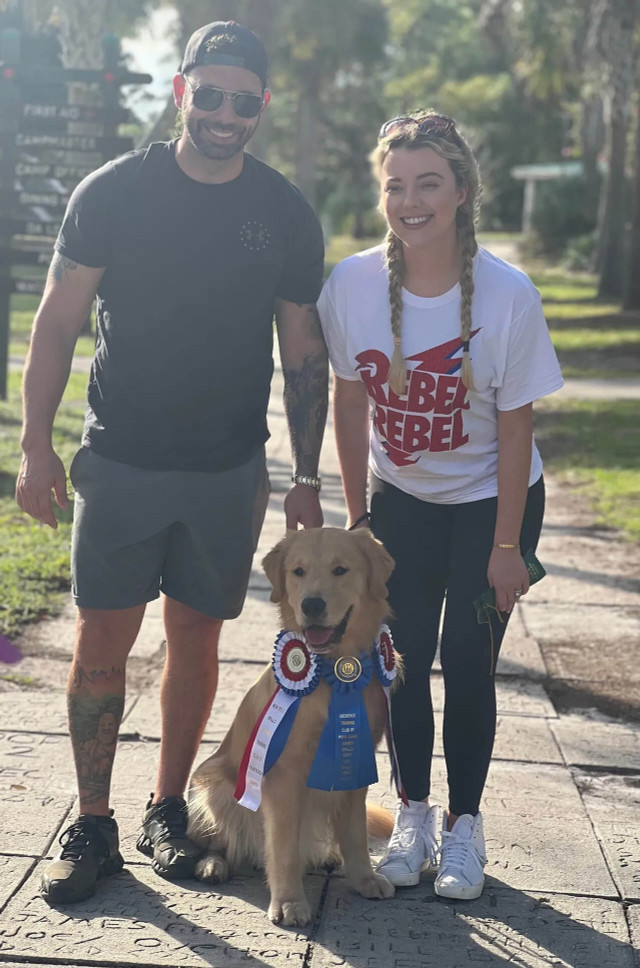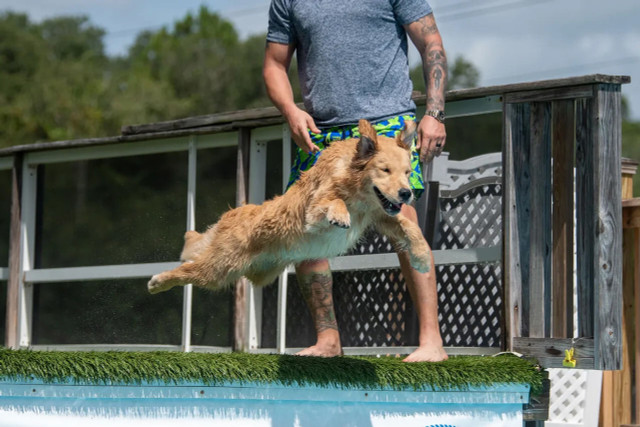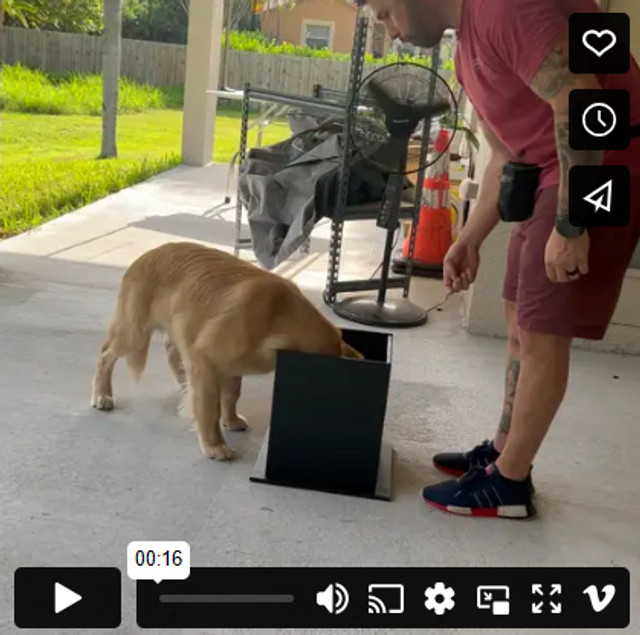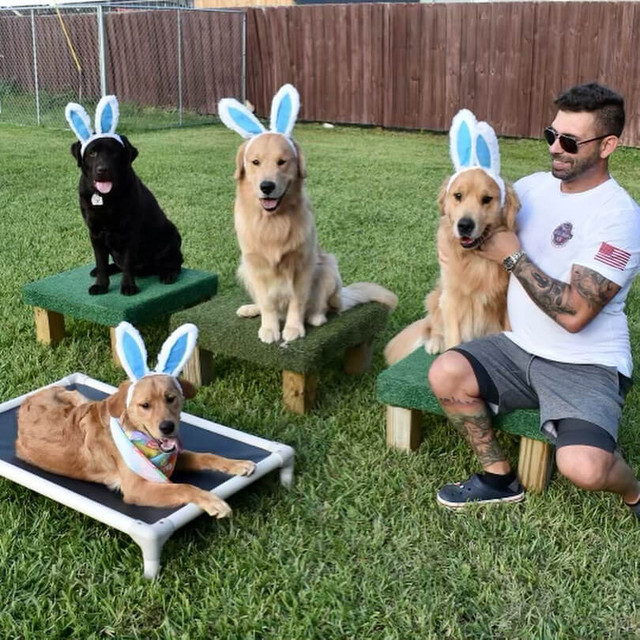
An interview with Christopher Armanini, of Full Send K9 Training.
Chris has an unusual approach to dog training that he picked up at one of the Nation's leading Police K9 Training facilities.
Kuranda: Tell us about Full Send K9
Full Send K9: Full Send K9 is a pet dog training operation where we instill basic obedience for pet dogs. All the basic manners, sit, down, come, leash manners, place. We do some other specialized training for detection and tracking dogs. A lot of dog sports, like dock diving and agility.
Kuranda: Is your wife involved?
Full Send K9: She's a full-time nurse, but she's just a dog lover at heart. She's always helping out with walking, grooming, brushing, and also she assists in some of the training. She's learning from all of her exposure being with me.
Kuranda: I'm assuming your training came because you were a police canine handler?
Full Send K9: I’ve been in the police 15 years. I’ve been involved with the K-9 unit since the day I started. I started with the Sheriff's Office. I started decoying for the K-9 unit. I'd wear the bite suit and I'd catch dogs. That's a totally different perspective from holding the leash, there's so much you learn from dog behavior and body language and reading a dog when you're actually catching them wearing a bite suit. That was an education in and of itself. I caught dogs as a decoy for eight years and then I finally made it into the canine unit where I became an assistant trainer with our canine academies.
Kuranda: What do you teach the dogs at your canine academy?
Full Send K9: Our (Police) agency is the largest canine unit on the East Coast besides NYPD. This has afforded me some once in a lifetime opportunities to train with some of the best people in the world. We have over 60 dogs, 28 to 30 right now are apprehension, dual purpose dogs, meaning they, work the streets, they track and apprehend suspects, and they also have some form of detection training whether it's explosives or narcotic. The rest of the dogs are single-purpose dogs whether it's just tracking for missing children or elderly. We have dogs that are cadaver dogs that they look for search and rescue for dead bodies. We have dogs that are trained to detect money. We have dogs that are trained to detect just firearms. We have therapy dogs now, which is the newest unit. These are pretty much just happy-go-lucky dogs that go to scenes of critical incidences where somebody might've lost a loved one and be a therapeutic dog for victims. We also have just single purpose narcotics dogs.
Kuranda: Your dog Rebel is amazing! How has he learned so many skills?
Full Send K9: A lot of people just stay in one lane in dog training. My police dog passed away a few years ago and it's always been very hard for me to have a dog just as a pet.
Rebel was actually a wedding gift for my wife when we got married last year. She's been in love with golden retrievers her whole life so I gave her one for a wedding present. He re-ignited everything that I had stored in my data bank of training.

Kuranda: How old is he?
Full Send K9: He is 16 months. What's crazy is I'm always learning something. I work with a lot of dogs and you learn something from all of them. Foundation work is so important for making an operant dog. “This is what I want to do." I don't show them the answers to everything. I make them free thinkers, that's where operant conditioning comes into play. You really make the dog problem solvers. Once they understand they know how to solve problems, they start thinking. Then they do things with such heart and soul. It's incredible. Most of my training is through marker training. I use a clicker and the verbal word yes. Basically it's Pavlov's theory of classical conditioning. A long time ago, Pavlov, a scientist was doing research on digestion in dogs. He'd ring a bell and give them food, ring a bell and give them food every day. One day he rings the bell and he sees that the dog starts salivating. That was a conditioned response to the sound of the bells. Through many repetitions they realized that the bell meant food is imminent. So I do that as my introduction to the marker and clicker training. I do what's called charging the marker. For about a week, I'll have a handful of food. I click, give food, click, give food, say yes, give food, yes, give food. That's called charging the marker. I'm giving value to that sound. They don't know what it means. I'm just tying in the food that they need to survive with a sound. This gives you a great way to communicate with the dog what you want. With puppies that I want to make truly thinkers I click and mark stupid things. I'll be on my patio where I train and if I have a cone, my project of the day is to have the dog touch the cone, I'll have the cone in the middle of the floor. I say nothing. I barely talk to dogs when I'm training them, 'cause I want them to discover things on their own. This is for the very operant dogs, They'll go and they'll look at the cone, they'll sniff it, and I mark it. He comes back to me, gets his reward, 'cause he understands the food, the marker means food. So what is he going to do again because he wants more food? He's going to go back to the cone. I mark it. Now what I have is this dog going out, touching the cone, coming back to me for the reward after I mark it. And that's where the marker is so beautiful is because you have that one and a half second time frame to either reinforce a behavior or enforce it. So at the speed of sound, I'm marking exactly what he's doing and he pairs it immediately to the behavior.
Kuranda: How do you train a dog to not do something?
Full Send K9: Well, that's where being a balanced trainer comes into play. Obviously dogs need to know what you want from them first before you can tell them what you don't want, right?
So working in the four quadrants of operant conditioning, you have positive punishment negative punishment positive reinforcement negative reinforcement, right? That has nothing to do with good or bad as far as positive negative it means adding to or taking away. If I'm training a dog and he's really not engaged, his mind is somewhere else. I say okay. I put him away. What am I doing? I'm taking away the thing that he wants. He wants food I'm removing him from it and then we'll try again later, so he'll realize
“I just had an opportunity to eat. I wasn't paying attention I'm not gonna do that again.” So it really creates fire and ignition. That's really what you need for step one to train a dog. That's not fair to them, old-school compulsion training was, you correct until he does what you want. That mentality doesn't work. You learn so much from working with these animals. You can really get them to do whatever you want, if it's the right dog. Every once in a while you get a diamond in the rough that has the drives to do a little bit of everything.
Kuranda: Is there a difference between various canine police dogs?
Full Send K9: Many smaller police agencies don't have the capability of training their own dogs in-house. Where I come from we train all our own dogs. They're about a year a year and a half when we get them and they have zero training. There's a lot of things in play.
We want to make sure their hips and elbows are good. We're going to be working 8 to 10 years with these dogs in very crucial environments. We need to really see what their natural god-given talent is without any training.
Kuranda: What breed of dogs do you normally work with?
Full Send K9: Shepherds and Malinois or a hybrid of both. That's what the military does too. We're looking for the drives that they naturally have you know their hunt drive, their food drive, their prey drive. There's so many different drives that we utilize in training, we kind of want to get ahead of the cart and make sure these dogs have the God-given talent before we even invest any money or time. Sure, or the energy too, or the focus, all the above. We train all our own dogs in-house. There's police agencies all over the country that buy dogs already trained. They'll go to the broker where they purchased them and do a two week crash course on how to handle the dog. That makes sense because there's a lot of police forces that probably only have one or two dogs. I feel that the bond you create with the dog, bringing him up together from ground zero, there is so much, they're so willing to do.

Kuranda: Do you offer training for Dock Dog sports?
Full Send K9: A lot of dogs naturally don't want to jump into bodies of water. That's where some dogs need to be trained. It's all about the introduction. I feel like a lot of people try to reason with dogs thinking that they think like humans do and they don't at all. If you have an apprehensive dog that's scared to walk into a lake, people will be like, "Oh, it's okay, it's okay, sweetie, come on, come on, come on." Well, what you're communicating to the dog is in your inflection in your voice is telling him it's okay to be scared. That's also why I see so many issues arise with pet dogs fear of thunder and lightning. The dog will be having a panic attack and they'll be petting him and caressing him. You know what that is communicating with him through body language is it's okay to be scared.
Kuranda: Are you a proponent of crate training?
Full Send K9: Dogs are burrowing creatures at heart. Crates are very important because it gives them their safe place where no harm can be done. I do a lot of emphasis on crate or kennel. I feed a lot in the crates and kennels. I create a lot of engagement with it and reward for being there so that can become a default safe place. If they're free ranging when that situation is going on and they're running around, what they're doing is creating more anxiety. I see a lot of dogs try to escape houses and rip door handles off of doors. What's happening is the movement is creating an elevated mental state and they're becoming more anxious. So confining and not letting them out when they're whining can help a lot. So if you pop the door on the crate when the dog is screaming, what's he gonna do next time? He's gonna scream, harder and longer and faster until the crate pops open. But if you pop the crate when he says nothing, he's gonna say nothing from the future to get out because they're in the moment creatures.
Kuranda: What is a dopamine box?
Full Send K9: I use it to desensitize dogs to external stressors. Basically, it's a 12 inch by 12 inch plastic box that you feed them, right? They stick their head in the box and food comes.
It rains food while their head is in the box. This is also one way that I teach detection at an imprinting stage. I'll put the odor in the same box, so their head is engulfed in this odor and food comes. Now food is an extreme dopamine generator for a dog's brain.
It's a very happy time. That's why they call it the dopamine box. So the dog's head is in the box and he's getting fed. Then I'll shoot off a gunshot. If he lifts his head out of the box, I do nothing. I say nothing. He puts his head back in the box, food starts coming again. Then I trigger another gunshot. Over repetitions, he'll realize that gunshot doesn't matter because I just want the food. You desensitize him to the external stressors. I might not start with a gunshot. I might start with just stomping my feet. The first shot will be a hundred yards away and I slowly close the gap until I'm shooting right next to him and he doesn't care.

Click to see a video of the dopamine box in use.
Kuranda: What about the isolation table?

Full Send K9: It's a table that's elevated, to put them more on an even playing field with me, 'cause I'm taller than dogs. You can do a ton of things. You can teach shake, sits and downs. If I'm working with a small dog, like a Yorkie, I'm gonna break my back trying to work with them. I could put them on isolation table, which elevates them to my level and I can shape, you know, sits and downs on it. They're a captive audience, they can't go anywhere. They have no choice but to pay attention to me.
Kuranda: What does Full Send mean?
Full Send K9: It's full throttle. It’s a Dock Diving slang term for giving it your all.
Kuranda: Did you have to teach Rebel to jump or did he already have the inclination to jump into a pool.
Full Send K9: First it started with a beach entrance. Very calm water with a with a gradual slope and I was feeding Rebel in the water. Every time he's getting the water. I'd mark it because I'm telling him this is what I want. Then he was eating his entire meal in the water. Once I saw he was comfortable with that, we start playing with balls and stuff like that in the water, you know, six four months old. Then it went to a pool and my buddy had a pool that has a sun deck on it. So about six inches is in water and then it falls off to three feet. I would stand in the pool, you know, up to my chest.
Rebel was on the sun deck in water and then I would call him to me and he would launch. Now, dogs are very competitive in nature. They see another dog do something, then they want to do it. So my buddy has a German Shorthair Pointer who's bonkers for the water. He saw her launching into the water and he's like "oh I'm gonna, I want to do that!" I do that a lot in training when I'm introducing new things. I'll use another dog that's proficient in something to show the other dog this is how you do it.
Kuranda: Why did you choose Kuranda bed?
Full Send K9: I've been through some of the other brands. I found these other ones are flimsy. The center stretches and they just fall apart. Some of these bigger dogs, I have a 104 pound golden doodle right now training. He'll bend any other brand of bed. The Kuranda’s are fantastic. The materials are strong. They can take a beating. I use them primarily for place training and place is so important for any dog really.

Full Send K9: I'll have three or four dogs out on place. I'll call each one individually by name, you know as a release, you know to come to me and they maintain their place on the Kuranda bed until until they're released. I use them for everything. A big dog ranch is not far from me at all and they have all Kuranda beds, over 200 Kuranda beds. They are the largest no-kill animal shelter in the world
Kuranda: Tell us about some of the training that you’ve gotten.
Full Send K9: I wanted to touch on that briefly because I think it's very important. All my formal training started in the canine unit, we were able to fly in trainers from all over the world. I learned my foundation for tracking from Dick Staal from Denmark. We flew him in twice for private training when I was in the unit. Two weeks each time and he's probably one of the best hard surface tracking instructors out there. Then we flew in Bart Bellon, who is a top tier dog trainer. He developed a system called New NePoPo® which is what all my training is based on. Everything that I do is NePoPo®. New NePoPo®means negative, positive positive. I trained with Bart for a week then I went to his official school in Missouri. His NePoPo®st silver and now I'm going to NePoPo® gold which is the top tier of their training schools in June and I'm doing that with Justin Rigney in Tennessee. NePoPo is just unbelievable in the way that you communicate with dogs where the dogs learn to make the right decision for themselves. I've done directional stuff with Pat Nolan. Pat Nolan's a phenomenal dog trainer.
Kuranda: What do you mean by directional?
Full Send K9: Directionals is using hand signals. Pat Nolan started as a duck dog guy and he was very very good. So then he started doing remote directionals, meaning dogs are wearing a two-way radio and a camera. He's sending dogs out over a mile watching them on a live camera telling them stop, look left, look right, go right. And they're using the dogs overseas for surveillance operating. So they're on a camera, they don't even have line of sight of the dogs. They're directing them remotely through this two-way radio, verbally, and the dogs are trained to look at windows and doors to to see which way they open. So for when a special force team is going to hit a location, the dog gathered all the intel for him. Then the dogs are trained to hide. So if somebody's coming, the dog will hide under a car or something readily available they see on camera.
For more information visit the Full Send K9 website.
